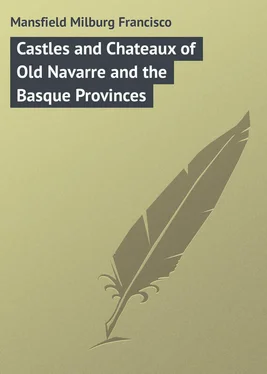Milburg Mansfield - Castles and Chateaux of Old Navarre and the Basque Provinces
Здесь есть возможность читать онлайн «Milburg Mansfield - Castles and Chateaux of Old Navarre and the Basque Provinces» — ознакомительный отрывок электронной книги совершенно бесплатно, а после прочтения отрывка купить полную версию. В некоторых случаях можно слушать аудио, скачать через торрент в формате fb2 и присутствует краткое содержание. ISBN: , Жанр: foreign_prose, на английском языке. Описание произведения, (предисловие) а так же отзывы посетителей доступны на портале библиотеки ЛибКат.
- Название:Castles and Chateaux of Old Navarre and the Basque Provinces
- Автор:
- Жанр:
- Год:неизвестен
- ISBN:http://www.gutenberg.org/ebooks/43609
- Рейтинг книги:4 / 5. Голосов: 1
-
Избранное:Добавить в избранное
- Отзывы:
-
Ваша оценка:
- 80
- 1
- 2
- 3
- 4
- 5
Castles and Chateaux of Old Navarre and the Basque Provinces: краткое содержание, описание и аннотация
Предлагаем к чтению аннотацию, описание, краткое содержание или предисловие (зависит от того, что написал сам автор книги «Castles and Chateaux of Old Navarre and the Basque Provinces»). Если вы не нашли необходимую информацию о книге — напишите в комментариях, мы постараемся отыскать её.
Castles and Chateaux of Old Navarre and the Basque Provinces — читать онлайн ознакомительный отрывок
Ниже представлен текст книги, разбитый по страницам. Система сохранения места последней прочитанной страницы, позволяет с удобством читать онлайн бесплатно книгу «Castles and Chateaux of Old Navarre and the Basque Provinces», без необходимости каждый раз заново искать на чём Вы остановились. Поставьте закладку, и сможете в любой момент перейти на страницу, на которой закончили чтение.
Интервал:
Закладка:
This may have been uncharitable and unchristianlike, but the placing of separate holy water-basins in the churches was simply carrying out the principle of no intercourse between the Basques and the cagots , not even between those who had become, or professed to be Christians. “The loyal hand of a Basque should touch nothing that had previously been touched by a cagot .”
From the Basque country, through the heart of the Pyrenees, circling Béarn, Navarre and Foix, to Roussillon is a far cry, and a vast change in speech and manners.
Life in a Pyrenean village for a round of the seasons would probably cure most of the ills that flesh is heir to. It may be doubtful as to who was the real inventor of the simple life – unless it was Adam – but Jean Jacques Rousseau was astonished that people did not live more in the open air as a remedy against the too liberal taking of medicine.
“ Gouter la liberté sur la montagne immense! ” This was the dream of the poet, but it may become the reality of any who choose to try it. One remarks a certain indifference among the mountaineers of the Pyrenees for the conventions of life.
The mountaineer of the Pyrenees would rather ride a donkey than a pure bred Arab or drive an automobile. He has no use for the proverb: —
“Honourable is the riding of a horse to the rider,
But the mule is a dishonour and a donkey a disgrace.”
When one recalls the fact that there are comparatively few of the bovine race in the south of France, more particularly in Languedoc and Provence, he understands why it is that one finds the cuisine à l’huile d’olive – and sometimes huile d’arachide , which is made from peanuts, and not bad at that, at least not unhealthful.
In the Pyrenees proper, where the pasturage is rich, cattle are more numerous, and nowhere, not even in the Allier or Poitou in mid-France, will one find finer cows or oxen. Little, sure-footed donkeys, with white-gray muzzles and crosses down their backs, and great cream-coloured oxen seem to do all the work that elsewhere is done by horses. There are ponies, too, – short-haired, tiny beasts, – in the Pyrenees, and in the summer months one sees a Basque or a Béarnais horse-dealer driving his live stock (ponies only) on the hoof all over France, and making sales by the way.
The Mediterranean terminus of the Pyrenees has quite different characteristics from that of the west. Here the mountains end in a great promontory which plunges precipitately into the Mediterranean between the Spanish province of Figueras and the rich garden-spot of Roussillon, in France.
French and Spanish manners, customs and speech are here much intermingled. On one side of the frontier they are very like those on the other; only the uniforms of the officialdom made up of douaniers , carabineros , gendarmes and soldiers differ. The type of face and figure is the same; the usual speech is the same; and dress varies but little, if at all. “ Voilà! la fraternité Franco-Espagnole ”.
One ever-present reminder of two alien peoples throughout all Roussillon is the presence of the châteaux-forts , the walled towns, the watch-towers, and defences of this mountain frontier.
The chief characteristics of Roussillon, from the seacoast plain up the mountain valleys to the passes, are the château ruins, towers and moss-grown hermitages, all relics of a day of vigorous, able workmen, who built, if not for eternity, at least for centuries. In the Pyrénées-Orientales alone there are reckoned thirty-five abandoned hermitages, any one of which will awaken memories in the mind of a romantic novelist which will supply him with more background material than he can use up in a dozen mediæval romances. And if he takes one or more of these hallowed spots of the Pyrenees for a setting he will have something quite as worthy as the overdone Italian hilltop hermitage, and a good deal fresher in a colour sense.
The strategic Pyrenean frontier, nearly six hundred kilometres, following the various twistings and turnings, has not varied in any particular since the treaty of the Pyrenees in 1659. From Cap Cerbère on the Mediterranean it runs, via the crests of the Monts Albères, up to Perthus, and then by the crests of the Pyrénées-Orientales, properly called, up to Puigmal; and traversing the Sègre, crosses the Col de la Perche and passes the Pic Nègre, separating France from the Val d’Andorre, crosses the Garonne to attain the peaks of the Pyrénées-Occidentales, and so, via the Forêt d’Iraty, and through the Pays Basque, finally comes to the banks of the Bidassoa, between Hendaye and Irun-Feuntarrabia.
The Treaty of Verdun gave the territory of France as extending up to the Pyrenees and beyond (to include the Comté de Barcelone), but this limit in time was rearranged to stop at the mountain barrier. The graft didn’t work! Roussillon remained for long in the possession of the house of Aragon, and its people were, in the main, closely related with the Catalans over the border, but the Treaty of the Pyrenees, in 1659, definitely acquired this fine wine-growing province for the French.
The frontier of the Pyrenees is much better defended by natural means than that of the Alps. For four hundred kilometres of its length – quite two-thirds of its entirety – the passages and breaches are inaccessible to an army, or even to a carriage.
From the times of Hannibal and Charlemagne up to the wars of the Empire only the extremities have been crossed for the invasion of alien territory. It is in these situations that one finds the frontier fortresses of to-day; at Figueras and Gerone in Spain; in France at Bellegarde (Col de Perthus), Prats-de-Mollo, Mont Louis, Villefranche and Perpignan, in the east; and at Portalet, Navarrino, Saint-Jean-Pied-de-Port (guarding the Col de Ronçevaux) and Bayonne in the west. Bayonne and Perpignan guard the only easily practicable routes (Paris-Madrid and Paris-Barcelona).
Hannibal and Charlemagne are the two great names of early history identified with the Pyrenees. Hannibal exploited more than one popular scenic touring ground of to-day, and for a man who is judged only by his deeds – not by his personality, for no authentic portrait of him exists, even in words – he certainly was endowed with a profound foresight. Charlemagne, warrior, lawgiver and patron of letters, predominant figure of a gloomy age, met the greatest defeat of his career in the Pyrenees, at Ronçevaux, when he advanced on Spain in 778.
Close by the Cap Cerbère, where French and Spanish territory join, is the little town and pass of Banyuls. This Col de Banyuls was, in 1793, the witness of a supreme act of patriotism. The Spaniards were biding their time to invade France via Roussillon, and made overtures to the people of the little village of Banyuls – famous to-day for its vins de liqueur and not much else, but at that time numbering less than a thousand souls – to join them and make the road easy. The procureur du roi replied simply: “ Les habitants de Banyuls étant français devaient tous mourir pour l’honneur et l’indépendance de la France .”
Three thousand Spaniards thereupon attacked the entire forces of the little commune – men, women and children – but finding their efforts futile were forced to retire. This ended the “Battle of Banyuls,” one of the “little wars” that historians have usually neglected, or overlooked, in favour of something more spectacular.
On the old “Route Royale” from Paris to Barcelona, via Perpignan, are two chefs-d’œuvre of the mediæval bridge-builder, made before the days of steel rails and wire ropes and all their attendant ugliness. These are the Pont de Perpignan over the Basse, and the Pont de Céret on the Tech, each of them spanning the stream by one single, graceful arch. The latter dates from 1336, and it is doubtful if the modern stone-mason could do his work as well as he who was responsible for this architectural treasure.
Читать дальшеИнтервал:
Закладка:
Похожие книги на «Castles and Chateaux of Old Navarre and the Basque Provinces»
Представляем Вашему вниманию похожие книги на «Castles and Chateaux of Old Navarre and the Basque Provinces» списком для выбора. Мы отобрали схожую по названию и смыслу литературу в надежде предоставить читателям больше вариантов отыскать новые, интересные, ещё непрочитанные произведения.
Обсуждение, отзывы о книге «Castles and Chateaux of Old Navarre and the Basque Provinces» и просто собственные мнения читателей. Оставьте ваши комментарии, напишите, что Вы думаете о произведении, его смысле или главных героях. Укажите что конкретно понравилось, а что нет, и почему Вы так считаете.












